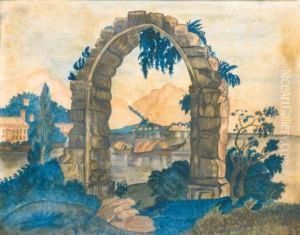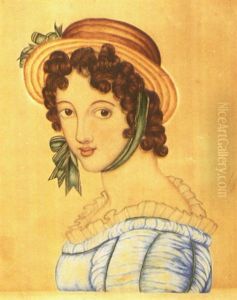Eunice Pinney Paintings
Eunice Pinney was an American folk artist known for her work in watercolor and as a creator of pictorial needlework. Born in 1770 in Windsor, Connecticut, Pinney lived during a time when America was still a new nation and its cultural identity was being formed. Not much is known about her early life, but it is believed that she was largely self-taught, a common situation for women artists of her era who had limited access to formal art education.
Pinney's work came to prominence in the early 19th century. Her most notable medium was watercolor painting, although she also worked extensively with textiles, creating intricate needlework pictures. These works were often done on silk or linen and were sometimes enhanced with paint or ink. Pinney's watercolors and needleworks are characterized by their detailed depictions of contemporary American life, including scenes of social gatherings, landscapes, and portraits. Her compositions often reflect the aesthetics of the time, exhibiting qualities of balance, order, and a delicate use of color.
Throughout her life, Eunice Pinney created numerous pieces, but her work was largely unrecognized by the larger art world until the 20th century. Her rediscovery came about when a collection of her watercolors was found in a trunk in the attic of a descendant's home. This led to greater recognition and appreciation of her contributions to American folk art. Today, her works are considered important examples of early American watercolor and needlework, and they provide valuable insight into the life and social customs of the early United States. Eunice Pinney's work is now included in the collections of several museums, including the American Folk Art Museum in New York.
Eunice Pinney passed away in 1849, leaving behind a legacy that continues to influence American folk art historians and collectors. Her life and work highlight the creativity and skill of women artists in the early years of the United States, and she is remembered as a pioneer in the field of folk art.





